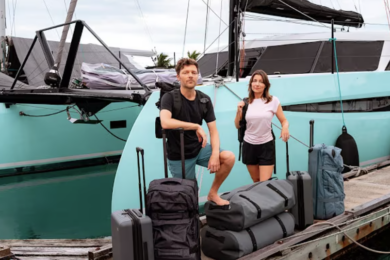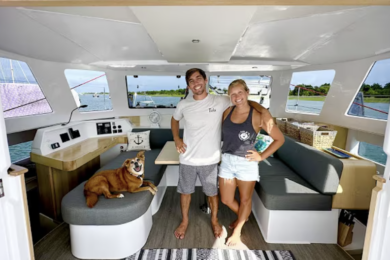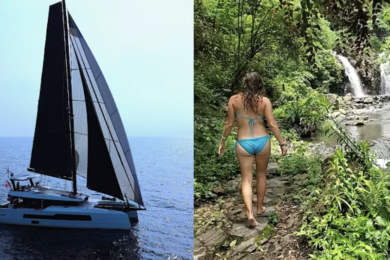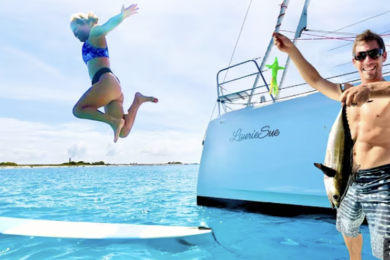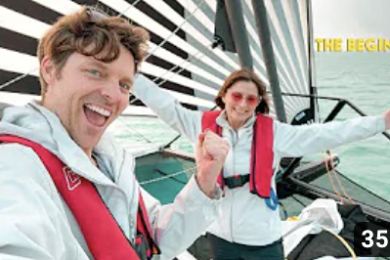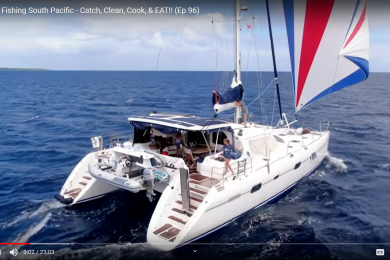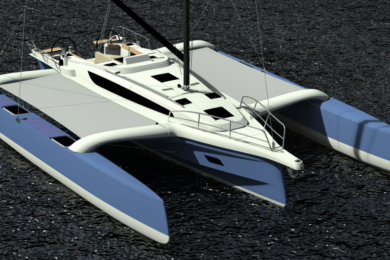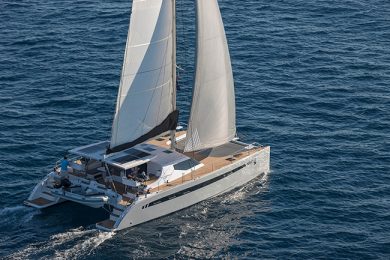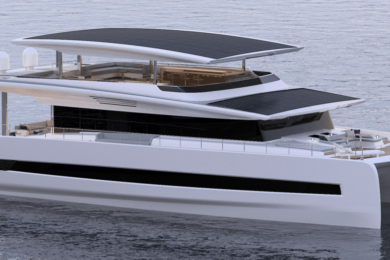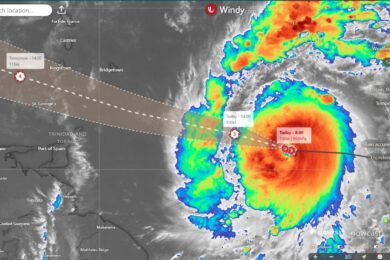Switching to a catamaran was a difficult decision but they have never looked back. (Published Summer 2015)

For a sailor who has sailed and loved monohulls for 45 years, the thought of changing to a catamaran was a difficult decision. Our boat at the time was a Tayana 52, a moderate displacement and good sailing yacht, with ample accommodations and beautiful lines. She had been our baby for 18 years, and a change from her would have to be for pretty darn good reasons.
About eight years ago, my wife and I came across a few different articles that touted the advantages of cruising in a catamaran. These articles really piqued our interest. From this input and subsequent discussions with knowledgeable catamaran sailors, we created our own list of the factors that were most important to us. This led us on a one year journey to select our catamaran Flash. In the end we decided on a performance cruising catamaran made by Catana, a 471 built in France in 2001. It has numerous construction features to make it relatively light, has a large sail-plan, sports daggerboards, and has narrow hulls to slide easily through the water. Now, seven years and 50,000 miles later, we decided to look back on these key factors and evaluate how well cruising in a catamaran has met our original objectives.

KEY FACTORS
Speed—This is often near the top of the list when cruisers talk about voyaging in a catamaran. Knowledgeable sailors had cautioned us not to expect too big a jump in sailing speed. The consensus was that one could plan on an overall one knot speed improvement over a long passage as compared to our moderate displacement monohull.
So what have we experienced? We have actually been pleasantly surprised by the speeds we have achieved. Many times we have done long runs on a beam reach at speeds that were three to six knots faster, and close hauled and downwind sailing about one knot, faster than our monohulls. Overall on longer passages we have found our average speed to be one to three knots faster. The key is being patient on departure windows to get those most favorable wind angles. Reaching in a cat is a lot of fun.
Sailing performance—We had expected that the performance cruising cat with daggerboards, narrow hulls, tall rig and lightweight construction would translate to good sailing performance on all points of sail, including going to windward. We had test sailed some similar cats, and found this to be the case. After many years and miles of sailing our catamaran, we have found her to be every bit as good at sailing as we had hoped. We often surprise many swift sailing larger monohulls, by pointing as well or higher, and passing them after a couple tacks.
Stability—We had expected that the catamaran would be lot more stable offshore, as well as in rolly anchorages. No surprise, we have found this to be true, but there are some interesting caveats. Cats are very stable in long period waves, however, shorter period waves like those from a power boat wake can at times provide some sharp rolls if a multiple of the wave period approaches the hull width of the catamaran – putting one hull on top of a wave and the other in a valley between waves. It doesn’t happen often, but gets your attention when it does.

Spaciousness— After touring many different make catamarans, we were amazed at the spacious feeling of the cabins, the cockpit area, the galley and the deck space. We expected the cat to be much more comfortable and enjoyable long term with these spacious areas. Looking back after several years of cruising with our cat, this has been well appreciated. It is also easier to find a quiet space away from the rest of the crew, maybe for a nap, quiet reading, just some personal time, or snoozing by our furry friends in a quiet corner where they won’t get trampled.
Visibility when inside—We loved the idea of the elevated salon on the catamaran for expansive views when inside, offshore or while at anchor. This has been the case, whether in a chilly morning in Maine, during a rainstorm in the Chesapeake, or just fixing dinner in the Caribbean. An added benefit we hadn’t considered originally, but has now become routine, is the ability to do most of our watch standing on passages from the comfort of the salon. Of course one needs to step out to trim or reef sails. All in all, we find the visibility excellent.
Easier on the body as one ages—We had expected that with the greater stability, we would experience less strain on one’s body and joints moving about when underway, allowing us to continue to sail longer as we aged. We bought the cat late in our 50’s, are now still comfortably sailing her well into our 60’s, and fully expect to be able to do this for many more years. Stress on joints and muscles is clearly less as we do our offshore passages as well as day-sails between islands.
Comfort on long passages—We had heard other cat owners tell us we would be amazed at how well we would be rested after a long passage. And they were right. The more stable sailing allows one to sleep comfortably and be better rested when on watch and when arriving at our destination. We have logged over 50,000 miles since we bought Flash with passages up to 10 days long, and have found this to be true.
More comfortable for guests—With the larger cabins and bunks, as well as larger living space we had hoped we would be able to entertain guests more comfortably with the catamaran. And that has proven to be true. Many times we have had guests join us in some distant location and comfortably stay aboard and not be in each other’s way.
OTHER BENEFITS
Besides those original attributes we had expected to experience in switching to a catamaran, our cruising over the past seven years has revealed some other attributes, most positive, and others not so positive. Here are the principal ones.
Fun light air sailing—We sail more. A pleasant surprise has been the ability to keep on sailing comfortably in light air conditions when we would have previously switched to the engine. Cats are just more easily driven.
Much drier—While sailing to windward in our monohulls often meant a fair amount of spray and green water over the decks, we have found the cat to be quite dry in comparison.

Larger refrigerator and freezer space—The larger refrigerator and freezer volume is a welcome feature we may not have appreciated when we originally made the switch.

Ease of installing new systems/equipment—large lockers and bilge space on the cat make running new wires or hose much easier than on a monohull.
Most often the party boat—We like this a lot. Not much more to say.
Ease of flying a spinnaker—Leading a guy to the tip of each hull allows one to fly a symmetrical spinnaker more readily than on a monohulls and with a shorthanded crew – no pole is required. And the large foredeck and trampoline area make hoisting or dousing a large symmetrical or asymmetrical spinnaker more stress free. We have both and use them regularly, aided by socks for dousing and large forward lockers for ready storage.
Cooking is easier offshore—On passage the more stable boat motion of the cat makes the cook happy, as well as the crew. We find less need for pre-cooked offshore meals.
Better ventilation—Salon ventilation in the cat allows more cooking and baking in warm climes.
Benefits of twin engines—This certainly provides more maneuverability and welcome redundancy, but also means twice the maintenance and more spares.
SOME CHALLENGES
Docking is more expensive—Space can be harder to find in marinas and haul out facilities, and slip rates are often higher. We knew this going in, but it is surprising how little accommodations are available for cats in some areas.
Tracking when sailing—Cats, since they don’t have a large keel, tend to wander more when sailing, where a monohull will track better. This requires a bit more work for the helmsperson when hand-steering and for the autopilot at other times.
Hdarder to get some parts—Cats are usually foreign built, so chasing down spares and replacement parts can be a challenge. It’s doable, but takes more time.
More challenging to get your sea-legs—The abrupt motion of shorter and more rapid boat dips takes some getting used to on a cat. It is not as rhythmic as a monohull.
More noise in a seaway—The large flat sections of cored hulls reverberate more when struck by a wave. In time this becomes less noticeable.
IN CONCLUSION
All in all, we are very happy with our decision. The cruising cat is the right boat for us with the long distance sailing and cruising we are doing. And the decision to go with a performance cruising cat works for us because we value sailing performance. We are happy to report the adventure continues.

Hank and his wife Seale have been lifelong sailors and made the switch to a Catana 471 performance cruising catamaran seven years ago after owning and sailing monohulls from 22 to 52 feet for 45 years. They have each logged 130,000 blue water miles.

